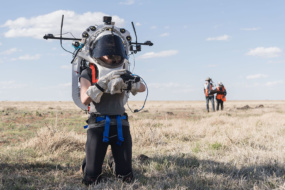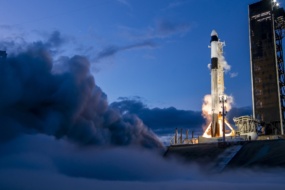Blue Origin aims to land its Blue Moon Mark 1 cargo vehicle on the Moon next year, setting an aggressive timeline as it seeks to chart a new course of decisive action and big swings after not reaching orbit in its first two decades of operations.
“We are expecting to land on the Moon in 12-16 months from today,” Blue’s SVP of lunar permanence John Couluris told 60 Minutes last weekend.
The cargo lander can transport 3,000 kg to the lunar surface—30 times the capacity of most CLPS landers but smaller than Blue Origin’s crewed lander that will be used for Artemis V.
Mark 1 Cargo Lander
In 2023, Blue Origin won a $3.4B Human Landing System (HLS) NASA contract to land the Artemis V crew on the Moon in 2029. Blue Origin will launch the lander—dubbed Blue Moon Mark 2—aboard its New Glenn rocket. The reusable crewed HLS lander will be refueled in lunar orbit and can carry 20 metric tons to the lunar surface.
Mark 1 cargo: Before HLS, the company announced plans to send its lighter uncrewed and non-reusable Mark 1 lander to the Moon next year to test the hardware. The simplified cargo mission requires just a single New Glenn launch and will not need refueling, life support, or a return flight.
Lightweight is relative: Blue Origin designed Mark 1 to ferry 3,000 kg of payload to the lunar surface, far surpassing the capacity of current CLPS landers, which can transport approximately 100 kg. The Intuitive Machines’s Odysseus lander that brought the US back to the Moon last month carried 130 kg of payload.
- While the first Mark 1 mission will be a demo, Blue Origin said its second cargo lander is expected to carry customer payloads.
- Blue Origin was selected to be a part of NASA’s Commercial Lunar Payload Service lander cohort in 2019, but has not yet been awarded a mission.
- NASA’s CLPS contracts pay ~$100M for 100 kg of payload delivered, a narrower scope than Blue’s 3,000 kg payload transporter capability.
Blue Origin’s Mark 1 lander will be powered by a single BE-7 engine, using liquid hydrogen as propellant.
New Glenn: The 2025 target lunar mission will be launched on Blue Origin’s reusable New Glenn launch vehicle, which is capable of transporting 45,000 kg to LEO.
The rocket has been in development for nearly a decade but has yet to launch. Blue Origin plans to change that in 2024—New Glenn rolled out to the launch pad for the first time last month, and company execs have committed to a maiden launch this year.
Blue is planning a quick ramp, CEO Dave Limp told Aviation Week.
- Expect two launches this year, with the goal of quickly ramping up to 12 launches annually.
- Blue is finishing construction of its fourth New Glenn reusable first stage.
- The company is aiming for a 30-day turnaround between booster flights.
Can Blue Origin land Mark 1 on the Moon in 12-16 months?
While Blue only recently won the large HLS lunar landing contract, it has been working on its lander since 2016 and it has been testing its BE-7 engine since 2019. With eight years of development under its belt, coupled with newfound risk tolerance and seemingly limitless resources, Blue Origin could be within shouting distance of the 12-16 month lunar landing timeline, but a lot would need to go right.
BE-4 success: The mission hinges on the success of New Glenn and the BE-4 engines that power the rocket. The BE-4 engines are also used on ULA’s Vulcan rocket, which performed well on its maiden flight earlier this year. The successful Vulcan flight that placed Astrobotic’s Peregrine lunar lander on the correct trajectory to the Moon, lends confidence in New Glenn’s debut.
New Shepard: While Blue has yet to reach orbit, it has flown its New Shepard rocket on 24 suborbital flights, including six crewed flights. Experience from New Shepard, which lands its booster post-flight, will help New Glenn’s maiden flight and the pinpoint controlled landing needed for a lunar touchdown.
Blue Origin vs. SpaceX: The company’s aggressive 12-16 month Mark 1 landing timeline could mean Blue Origin reaches the Moon with a sizeable payload before SpaceX. SpaceX is also working toward an uncrewed Moon landing in 2025 with its Starship HLS, but its mission is significantly more complex. SpaceX aims to deliver 100 metric tons to the lunar surface in a single landing, requiring approximately 10 tanker refuelings in LEO. In contrast, Mark 1’s flight is a single-launch to the Moon and carries 3 metric tons.
Blue Origin Rebrand
Formed in 2000—a year and a half before SpaceX—Blue Origin has long had the reputation of the sleeping giant who has yet to be woken up. Bezos is looking to change that tune, committing his full attention (and a whole lot of dough) to the venture ahead of what will be a defining two years for the company.
“We are going to become the world’s most decisive company,” Jeff Bezos told podcaster Lex Fridman. ”We are going to get really good at taking appropriate technology risks, making those decisions quickly, being bold on those things, and having the right culture to support that.”
New leadership: Late last year, Bezos tapped Dave Limp—a former Amazon executive—to take over as CEO and facilitate the culture shift. Limp does not have a rocket, aerospace, or industrial background–-but was selected to bring a sense of urgency and leadership to the company.
Footing the bill: Blue Origin employs ~11,000 people, just shy of SpaceX’s ~13,000 employees. If we assume a salary/benefits cost of $150,000 per year, Blue’s payroll would come in at around $1.7B a year
With the help of a giant workforce, the company is making billion-dollar bets on nearly every facet of heavy space infrastructure.
- Heavy lift rocket (New Glenn)
- Lunar lander (Blue Moon)
- Space station (Orbital Reef)
- Space tug (Blue Ring)
- Engine supplier (BE-4 / BE-7)
- Crewed spacecraft, as reported by Ars Technica.
- Plus, it may soon be the new owner of ULA, as we detailed last week.
“I want take the financial winnings that I got from starting Amazon and I want to take that and use it to build heavy infrastructure for space, so that the next generation of entrepreneurs can do what I did with Amazon,” Jeff Bezos said in a fireside chat at the Lake Nona Impact Forum last week.




